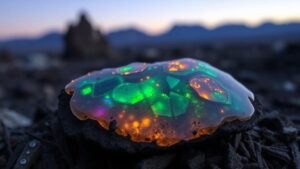Volcanic Fossil Fields: Discovering Ancient Creatures Preserved in Ash Layers
Volcanic Fossil Fields: Discovering Ancient Creatures Preserved in Ash Layers
Volcanic fossil fields offer an intriguing glimpse into the past, showcasing ancient creatures preserved in layers of volcanic ash. For rockhounds and mineral collectors, these sites provide a unique opportunity to explore the geological processes that contribute to fossilization, while also uncovering valuable specimens. This article delves into the formation, significance, and collection practices associated with these remarkable sites.
The Formation of Volcanic Fossil Fields
Volcanic fossil fields are formed as a result of volcanic eruptions that deposit ash and other materials over a landscape. When organisms are caught in these eruptions, they can become buried under layers of ash, which helps protect them from decomposition. The ash deposits create an anaerobic environment, slowing down the process of decay and allowing for the preservation of the organisms details.
According to research published in the journal Geology, rapid burial is crucial for fossilization, as it can occur within hours to days after an organism’s death. For example, when Mount St. Helens erupted in 1980, the immediate volcanic ash fall resulted in the preservation of various trees, animals, and plant life, providing a modern-day example of this phenomenon.
Types of Fossils Found in Volcanic Fossil Fields
Volcanic fossil fields contain a wide array of fossil types, ranging from microscopic organisms to large vertebrates. Examples include:
- Trace Fossils: Evidence of the activities of ancient organisms, such as footprints or burrows.
- Body Fossils: Actual remains of organisms, including bones, shells, and plant materials.
- Microfossils: Tiny fossilized organisms, such as pollen or diatoms, that can reveal significant information about the ancient environment.
The volcanic ash not only helps in the preservation of these fossils but can also provide valuable information about the environmental conditions at the time of the organisms life, such as temperature and atmospheric composition.
Notable Volcanic Fossil Sites
Several key sites around the world are renowned for their volcanic fossil fields. These locations serve as hotspots for paleontologists and collectors alike:
- La Brea Tar Pits, California: While not strictly volcanic, the tar pits are a remarkable example of preservation in a unique geological setting.
- Hawaii Volcanoes National Park: This park features a variety of preserved flora and fauna, as well as unique lava formations.
- Mount St. Helens, Washington: The 1980 eruption offered unprecedented insights into rapid fossilization processes.
Techniques for Collecting Volcanic Fossils
When it comes to collecting fossil specimens from volcanic fields, there are several important techniques and guidelines to follow:
- Research Local Regulations: Ensure that you understand local laws regarding fossil collection, as some areas may be protected.
- Proper Tools: Equip yourself with tools like chisels, hammers, and brushes to gently extract fossils without damage.
- Field Documentation: Take notes on the fossil’s location, surrounding geology, and any observations regarding its context.
Also, consider using geologic maps to locate areas with a rich history of volcanic activity, as these regions are likely to yield more significant fossil discoveries.
Preservation and Conservation Efforts
While collecting fossils is an exciting endeavor, it also comes with responsibilities. Conservation efforts are essential in maintaining the integrity of fossil sites. Consider the following:
- Join Local Fossil Clubs: Engaging with experienced collectors can enhance your knowledge and promote responsible collection practices.
- Participate in Clean-Ups: Help maintain sites by removing litter and preserving the environment for future generations of collectors.
Conclusion: The Rich Tapestry of Life in Ash
Volcanic fossil fields hold a treasure trove of information about the earth’s biological history. For rockhounds and mineral collectors, these sites are not only a source of unique specimens but also offer an opportunity to connect with the past. By understanding the processes of fossilization, employing responsible collection practices, and participating in conservation efforts, collectors can contribute to the preservation of these remarkable geological narratives.
In summary, the study of volcanic fossil fields allows us to glean insights into ancient ecosystems while providing a thrilling pursuit for fossil enthusiasts. Whether you’re a novice collector or a seasoned paleontologist, the ash-covered landscapes of the past await your discovery.



